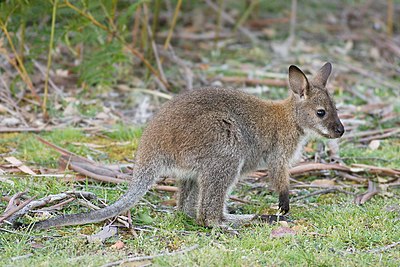
Search
Conservation in Australia

Conservation in Australia is an issue of state and federal policy. Australia is one of the most biologically diverse countries in the world, with a large portion of species endemic to Australia. Preserving this wealth of biodiversity is important for future generations. 25% of Australia is managed for conservation.
Animal habitats like reefs and forests must be preserved in order to preserve the population and diversity of animal species. Conservation is vital for future study and for field research to be taken, and because biological richness is an unmeasurable aesthetic that may be developed into commercial recreational attractions.
According to Janine Benyus, the potential for advances in biomimicry in Australia is great because the extreme weather and conditions found here provide an excellent evolutionary incubator. Research on natural processes can only occur if the habitat is preserved and organisms continue to thrive.
Federal and State governments manage protected areas and national parks; a number of non-governmental organizations are also involved in conservation.
Conservation issues
A key conservation issue is the preservation of biodiversity, especially by protecting the remaining rainforests. The destruction of habitat by human activities, including land clearing, remains the major cause of biodiversity loss in Australia. The importance of the Australian rainforests to the conservation movement is very high. Australia is the only western country to have large areas of rainforest intact. Forests provide timber, drugs, and food and should be managed to maximize the possible uses. Currently, there are a number of environmental movements and campaigners advocating for action on saving the environment, one such campaign is the Big Switch.
Land management issues including clearance of native vegetation, reafforestation of once-cleared areas, control of exotic weeds and pests, expansion of dryland salinity, and changed fire regimes. Intensification of resource use in sectors such as forestry, fisheries, and agriculture are widely reported to contribute to biodiversity loss in Australia. Habitat fragmentation is one of the most important factors affecting the persistence of species. Coastal and marine environments also have reduced biodiversity from reduced water quality caused by pollution and sediments arising from human settlements and agriculture. In central New South Wales where there are large plains of grassland, problems have arisen from—unusual to say—lack of land clearing.
Shark culling (the killing of sharks) currently occurs in New South Wales and Queensland (in government "shark control" programs). These programs have damaged the marine ecosystem. Roughly 50,000 sharks have been killed by Queensland authorities since 1962, including in the Great Barrier Reef. Queensland's "shark control" program has been called "outdated, cruel and ineffective". The "shark control" programs in New South Wales and Queensland have killed thousands of animals, such as turtles and dolphins. In 2018, the Humane Society International filed a lawsuit against the government of Queensland to stop shark culling in the Great Barrier Reef.
The protection of the iconic Wollemi Pine is an important conservation issue because the tree is one of the rarest in the world. There are only 46 mature individual trees remaining in the wild. The small grove of unusual conifers in a remote canyon are threatened due to its highly restricted distribution, extremely small population size, the ongoing impacts from exotic pathogens, inappropriate fire regimes, unauthorized site visitation and climate change.
Specific issues:
- Blue Gum Forest
- Fraser Island
- Franklin Dam
- Lake Pedder
- Uranium mining in Kakadu National Park
- Plight of the Murray River system
Legal framework
Conservation of the natural environment in Australia is derived from five different sources of law, namely international law, federal law, State law and local government law as well as the application of the common law.
International environmental law
International agreements that affect conservation policy in Australia.
Federal law
The primary federal law is the Environment Protection and Biodiversity Conservation Act 1999 (Cth), usually referred to as the EPBC Act.
Protected areas
There are numerous protected areas in all States and Territories that have been created to protect and preserve Australia's unique ecosystems. Protected areas include national parks and other reserves, as well as 64 wetlands which are registered under the Ramsar Convention and 16 World Heritage Sites. As of 2002, 10.8% (774,619.51 km2 or 299,082.26 sq mi) of the total land area of Australia is within a protected area. Protected marine zones have been created in many areas to preserve marine biodiversity; as of 2002 they cover about 7% (646,000 km2 or 249,000 sq mi) of Australia's marine jurisdiction.
Protected areas of include those managed by the federal Department of the Environment and Energy, and national parks and other protected areas managed by the states, Agencies responsible for protected areas include:
- Director of National Parks
- Great Barrier Reef Marine Park Authority
- New South Wales Department of Environment and Climate Change
- Parks Victoria
- Queensland Parks and Wildlife Service
- Department of Environment and Water (South Australia)
- Department of Environment and Conservation (Western Australia)
- Tasmania Parks and Wildlife Service
- Chief Minister's Department (Australian Capital Territory)
- Parks and Wildlife Commission of the Northern Territory
Threatened species
Conservation organisations
A number of governmental and non-governmental organisations work in the conservation and restoration of the Australian environment.
References
External links
- State of the Environment reporting
Text submitted to CC-BY-SA license. Source: Conservation in Australia by Wikipedia (Historical)
Articles connexes
- Conservation Volunteers Australia
- Roadside conservation
- Conservation park (Australia)
- List of environmental organizations
- Environmental issues in Australia
- Conservation reserves of South Australia
- Australian Conservation Foundation
- Australia
- Cane toads in Australia
- Conservation status
- In-situ conservation
- Department of Environment and Conservation (Western Australia)
- Environment Protection and Biodiversity Conservation Act 1999
- Australian Marine Conservation Society
- Conservation Council of Western Australia
- Conservation Council
- Bird Observation & Conservation Australia
- Conservation in Indonesia
- Environmental movement in Australia
- Conservation Council of South Australia
Owlapps.net - since 2012 - Les chouettes applications du hibou


